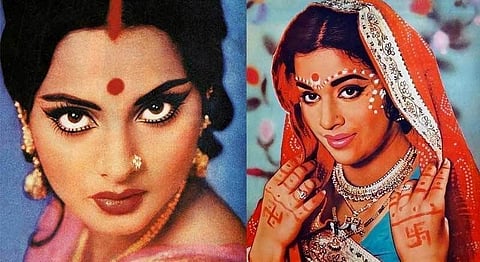
- HOMEGROWN WORLD
- #HGCREATORS
- #HGEXPLORE
- #HGVOICES
- #HGSHOP
- CAREERS
- ABOUT US
- CONTACT US

I remember a time en route to a wedding in a Toyota, stuffed with my extended family members and a particularly loud and wailing cousin. The car was made to turn around when we were almost halfway to the venue because one of my aunts had forgotten to wear a bindi. In her defense, she felt incomplete without it and none of the women, including me, were ready to part with ours. So exactly what and who is the bindi that won precedence over more than half a trip in this case?
The bindi, also known as tikli, is a decorative mark worn in the middle of the forehead. While it was traditionally worn by Hindu women and was often indicative of their caste, religion and marital status, it has been a global phenomenon for a while –– it has been worn by Hollywood celebrities from Madonna to Miley Cyrus. While the cultural appropriation conversation of the bindi is for another time, have you ever wondered how the bindi was worn when you couldn’t stick it to your forehead? We did, and delved right into a well of archives to glean some insight into the vintage world of the bindi.
The word bindi is believed to have its origin in ancient Sanskrit texts on face decoration and also has spiritual implications of being the point of unity of the cosmos in ancient Hindu philosophy. The traditional material used for the bindi were vermilion, sandalwood and ash.
Digging its history was a tough task and once the internet failed, I turned to my 75-year old grandmother for some bindi wisdom. According to her, in the 20th Century, the most common way to get the bindi to stick to your forehead was to apply a bit vaseline or any other wax-like cream in a circular form on the forehead that would act as glue for the vermillion. If your sense of geometry wasn’t too great and wonky looking circular bindis were not your style, you could always trace the perfect bindi on your forehead with bindi paper cutouts of various shapes and designs available in the market.
After the bindi broke out of the rigid barriers of tradition, however, it decided to create some standard trends. These are some of the popular ones that caught our eye.
I. The Tiny Red Bindi
This urban trend popped up during the 1930s and 1940s and appealed to the new modern woman of India in an amalgamation of chic and traditional. Many style icons of the time like Maharani Gayatri Devi and pioneer of 20th century modern Indian art, Amrita Sher-Gil, sported this look.
II. The Decorative Bindi
In the 1950s, the bindi was bored of being a mundane dot and it became more experimental by appearing in decorative designs mostly popularised by actresses of the Indian film industry.
III. The Tilaka Bindi
The feminine decorative bindi took on the bold design of the Tilaka; the elongated forehead mark in the 1950s and 1960s.
While the bindi was making waves in fashion trends, women were also looking for an easier way to apply it. Out came Shingar kumkum –– a liquid form of kumkum, that would dry on the forehead like a bindi. And it’s still around today!
But between the lac bindis of the early 20th century and the felt bindis of today, there was also the age of the plastic stick-on bindi. Made of stiff but pliable plastic, it had a bright and smooth surface and came in more than a few colours.
Then, in 1986, after years of dealing with sticky gum or perspiration that would ruin a perfect circle came Shilpa Bindis; the first brand in India to introduce easy-to-use stick-on bindis punched from imported maroon felt, with glue that didn’t stain skin! After that, the bindi exploded into an industry that produced it in every shape, size, texture, embellishment and colour. From matte, pastel, neon, drop-shaped, laser-cut, tiny, oversized and outrageous, the bindi became a timeless fashion icon like no other.
To know more about the secret life of the bindis, visit Vintage Indian Clothing’s post; All About The Bindi here.
If you like this, you may also enjoy:
